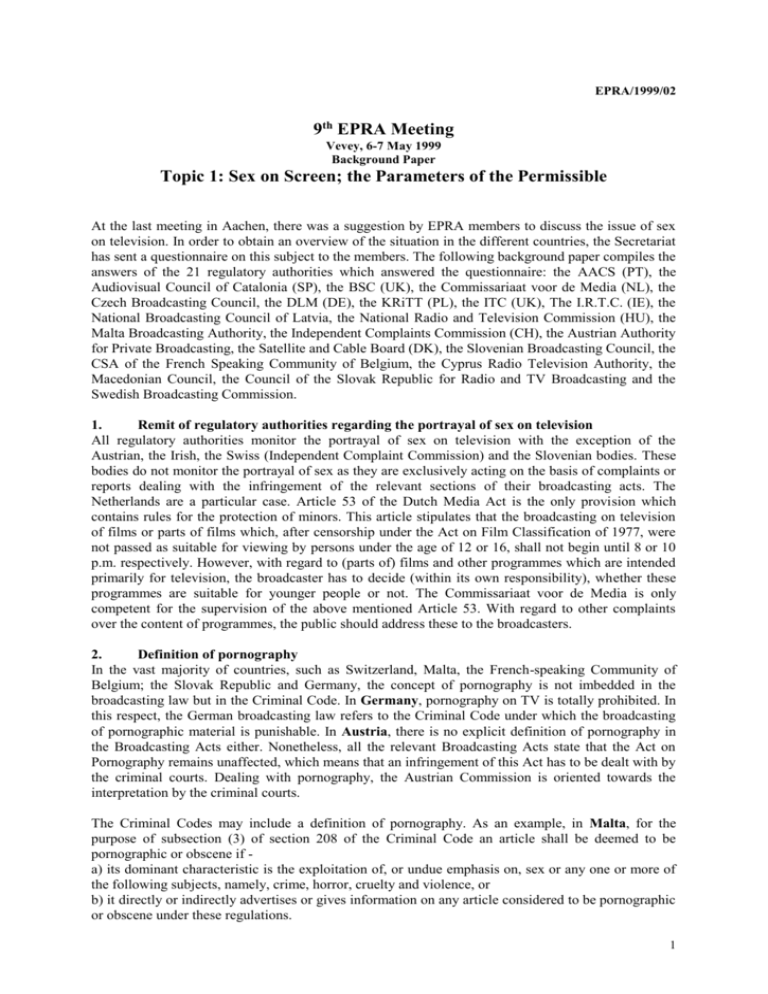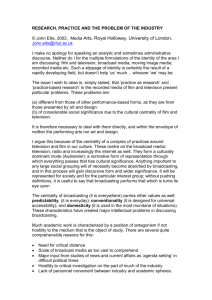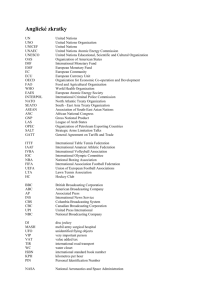
EPRA/1999/02
9th EPRA Meeting
Vevey, 6-7 May 1999
Background Paper
Topic 1: Sex on Screen; the Parameters of the Permissible
At the last meeting in Aachen, there was a suggestion by EPRA members to discuss the issue of sex
on television. In order to obtain an overview of the situation in the different countries, the Secretariat
has sent a questionnaire on this subject to the members. The following background paper compiles the
answers of the 21 regulatory authorities which answered the questionnaire: the AACS (PT), the
Audiovisual Council of Catalonia (SP), the BSC (UK), the Commissariaat voor de Media (NL), the
Czech Broadcasting Council, the DLM (DE), the KRiTT (PL), the ITC (UK), The I.R.T.C. (IE), the
National Broadcasting Council of Latvia, the National Radio and Television Commission (HU), the
Malta Broadcasting Authority, the Independent Complaints Commission (CH), the Austrian Authority
for Private Broadcasting, the Satellite and Cable Board (DK), the Slovenian Broadcasting Council, the
CSA of the French Speaking Community of Belgium, the Cyprus Radio Television Authority, the
Macedonian Council, the Council of the Slovak Republic for Radio and TV Broadcasting and the
Swedish Broadcasting Commission.
1.
Remit of regulatory authorities regarding the portrayal of sex on television
All regulatory authorities monitor the portrayal of sex on television with the exception of the
Austrian, the Irish, the Swiss (Independent Complaint Commission) and the Slovenian bodies. These
bodies do not monitor the portrayal of sex as they are exclusively acting on the basis of complaints or
reports dealing with the infringement of the relevant sections of their broadcasting acts. The
Netherlands are a particular case. Article 53 of the Dutch Media Act is the only provision which
contains rules for the protection of minors. This article stipulates that the broadcasting on television
of films or parts of films which, after censorship under the Act on Film Classification of 1977, were
not passed as suitable for viewing by persons under the age of 12 or 16, shall not begin until 8 or 10
p.m. respectively. However, with regard to (parts of) films and other programmes which are intended
primarily for television, the broadcaster has to decide (within its own responsibility), whether these
programmes are suitable for younger people or not. The Commissariaat voor de Media is only
competent for the supervision of the above mentioned Article 53. With regard to other complaints
over the content of programmes, the public should address these to the broadcasters.
2.
Definition of pornography
In the vast majority of countries, such as Switzerland, Malta, the French-speaking Community of
Belgium; the Slovak Republic and Germany, the concept of pornography is not imbedded in the
broadcasting law but in the Criminal Code. In Germany, pornography on TV is totally prohibited. In
this respect, the German broadcasting law refers to the Criminal Code under which the broadcasting
of pornographic material is punishable. In Austria, there is no explicit definition of pornography in
the Broadcasting Acts either. Nonetheless, all the relevant Broadcasting Acts state that the Act on
Pornography remains unaffected, which means that an infringement of this Act has to be dealt with by
the criminal courts. Dealing with pornography, the Austrian Commission is oriented towards the
interpretation by the criminal courts.
The Criminal Codes may include a definition of pornography. As an example, in Malta, for the
purpose of subsection (3) of section 208 of the Criminal Code an article shall be deemed to be
pornographic or obscene if a) its dominant characteristic is the exploitation of, or undue emphasis on, sex or any one or more of
the following subjects, namely, crime, horror, cruelty and violence, or
b) it directly or indirectly advertises or gives information on any article considered to be pornographic
or obscene under these regulations.
1
Provided that an article shall not be considered to be pornographic or obscene to the extent that it
serves the public good on the ground that it is in the interests of science, literature, art or learning or
other subjects of general concern.
The Criminal Code of the Slovak Republic also contains a definition of pornography. The Code
makes a difference between soft and hard-core pornography. Soft pornographic material harmful for
the morality of young people should not be available for young people under 18. Some forms of
pornography such as child pornography, zoophylia or necrophylia, forms related to violence and
impairing of human dignity are banned.
However, this is not always the case. As an example, the German Criminal Code does not define
pornography. The concept is subject to prevailing moral attitudes.
According to the interpretation in current legal practice a portrayal is pornographic when:
sexual actions shown are prominent in an extremely obtrusive way,
the portrayals primary purpose is solely and predominantly intended to stimulate sexual arousal
and when the portrayal is not in accordance with commonly accepted social values and norms.
Moreover, the following two conditions must be satisfied with regards to the above definition:
With reference to the content, human beings are reduced to physiological “stimulus-responsebeings“ and degraded to substitutable objects of sexual desire.
With reference to the presentation, sexual actions must be shown in a very detailed way and not
defamiliarized.
Besides the fiction of the inexhaustible potency and the untiring willingness for sex of the
participants, the proportion of sequences with genital stimulation and sexual intercourse during the
total length of the programme will contribute to the classification of a programme as pornographic.
In the UK and Cyprus, the relevant concept is obscenity rather than pornography and is to be found
in the Obscene Publications Act of 1963. The Act which covers broadcasting as well as print defines
obscenity as material which tends to “deprave and corrupt”.
Most of the broadcasting laws only include a provision - mostly based on the wording of article 22 of
the Directive Television without Frontiers or on Article 7 of the Convention on Transfrontier
Television - stating that the programmes should not contain pornography. As an example, Art. 24
quater of the Decree of the French Community of Belgium on broadcasting of 17.07.1987 states that
“The RTBF and the relevant broadcasters are not allowed to broadcast programmes which are likely
to seriously impair physical, mental or moral development of minors, in particular programmes
including pornography or gratuitous violence”. In Ireland, Section 9 (1) (d) of 1988 Act stipulates
that every contractor shall ensure that ... “anything which may reasonably be regarded as offending
against good taste or decency...is not broadcast by him”.
The existing definitions of pornography are not always considered satisfactory by the regulatory
authorities. The Maltese Broadcasting Authority considers that the definition is too generic and
does not provide a clear interpretation of pornography/obscenity by which such material could be
objectively adjudicated. The ITC remarked that even if the definition of obscenity was interpreted in
widely different ways by policy forces and prosecution authorities this was not a problem for
broadcasting since the standards set (in order to avoid “ offending against good taste or decency”) are
tougher. The BSC considered that the same definition was imprecise and difficult to interpret.
Moreover, since it was written in 1963, there have been changes in attitude.
2
3.
Watershed provisions
11 out of the 21 authorities which answered the questionnaire have a watershed system applying to
sex on television.
In Austria, for the time being, only ORF, the public service broadcaster has introduced a rating
system for films which are broadcast later than 10 p.m. According to internal guidelines, before 8 p.m.
all broadcasts have to be suitable for the whole family. Between 8 and 10 p.m., broadcasts which
could impair the development of minors are forbidden. The ORF is also bound by law to provide
flawless or impeccable entertainment.
In Sweden, although there is no real watershed system in the legislation, the Broadcasting
Commission applies certain provisions in the licence terms to implement a 9 p.m. watershed.
In Cyprus, the watershed starts at 21.00 p.m. during weekdays and 22.00 during the weekend and
lasts until 5.30 the following morning. During this time only programmes suitable for audiences aged
15 and under may be shown.
In the Czech Republic, further to the Broadcasting Act section 5, art.1 of 1991, the operators are
required not to air from 6.00 a.m. to 10.00 p.m. any programmes that could jeopardise the mental or
moral development of children and minors.
Similarly, in the Slovak Republic, programmes which are likely to endanger the moral and
psychological development of children and youth can only be broadcast from 10 p.m. to 6 a.m.
In Germany, broadcasts that may endanger the physical, mental or emotional well-being of minors
may not be transmitted unless the broadcaster takes steps to ensure, through the timing of the
broadcast or in some other manner, that minors in the age groups concerned will not normally see or
hear the programmes in question. The broadcaster may assume this to be the case for broadcasts
between 11.00 p.m. and 6.00 a.m. In choosing the time to broadcast films which have passed a 12+
classification, consideration shall be given to the well-being of younger children. Films which have
passed a 16+ classification may only be broadcast between 10.00 p.m. and 6.00 a.m., and films
classified 18+ only between 11.00 p.m. and 6.00 a.m.
In Denmark, pornography should only be broadcast after midnight. Soft porn should only be send
after 9.00 p.m.
In the UK, terrestrial broadcasters must ensure that nothing is broadcast that is unsuitable for children up
to 9 p.m. and there must be a gradual progression towards more adult material rather than a sudden
change, i.e. in practice the more explicit material is after 10 p.m.
In Malta, the television watershed system applies from 9.00 p.m. onwards when parental control is
expected to be exercised more rigorously vis-à-vis children’s viewing. After 9.00 p.m. programmes of
a progressively adult nature are allowed.
In Macedonia, Art. 35 Section: 2, 3, 4 states that programmes should not have indecent content,
especially pornography and violence. Films and other shows which could have a damaging influence
upon the psycho-physical development of children and youth may be shown only between 24.00 and
6.00 a.m.
In Hungary, programmes which may have an adverse effect upon the development of the personality
of minors, in particular, programmes presenting the gratuitous use of violence as an example of
conduct to follow and programmes presenting sex for its own sake, may only be broadcast between
23.00 and 5.00 hours.
In Latvia, further to Art. 18 (4) of the Law on Radio and Television, broadcasting organisations must
not distribute programmes and broadcasts harmful to the normal physical, mental and moral
developments of children and teenagers, except in cases when a specific broadcast time is selected for
such broadcasts (between 22.00 and 7.00 hours) or technical blocking devices are used (coded
broadcasts).
4.
Differences between free TV and pay-TV
Suprisingly enough, in the vast majority of the countries, the same legal provisions apply for free-TV
and pay-TV. However, one has to take into account that in some countries such as Austria or
Macedonia, there is no pay-TV to date. In the Netherlands, the same provisions have been applied to
free and pay-TV since the latest amendment of the Media Act of 19 October 1998, which came into
force on 15 December 1998. Before this recent amendment, pay-TV channels were not bound by any
3
restrictions on the scheduling of their programmes. The reason for the former distinction between
open channels on the one hand and subscriber channels on the other hand was that pay-TV
programmes can only be received by means of a decoder. Moreover, the viewer has to conclude an
agreement with the programme provider. Due to these circumstances, it was considered that minors
would not easily be able to watch programmes that were not suitable for them. The Dutch legislator
has now chosen to treat all broadcasters in the same way and has put an end to the legal distinction.
In Cyprus, the watershed does not apply for pay-TV stations.
In Denmark, if the programmes are coded there are no watershed rules.
In the UK, the watershed for premium subscription services is 8.00 p.m. instead of 9 p.m. Moreover,
the ITC has allowed (on an experimental basis), the use of security mechanisms (e.g. pin system), to
replace time based watersheds for pay per view.
In Sweden, free TV which requires a licence - basically public service TV - has stricter rules which
are to be found in the licence.
5.
Differences between digital TV and analogue TV
In the vast majority of countries, the same legal provisions apply to digital and analogue TV.
However, once again, one has to take into account that there is either no digital TV in several
countries such as Austria, Cyprus and Macedonia at the time being or that no specific legislation has
been enacted yet - as in Poland for example. In Sweden, digital TV requires a licence and the same
provisions as public TV regarding sex are applied.
6.
Rating systems
A considerable number of countries have now adopted a rating system for TV programmes. However,
these systems were not specifically created for the portrayal of sex as they also apply to violent
programmes.
In Austria, ORF, the public service broadcaster, has recently introduced a rating system. According
to this system, the films are labelled (during their whole duration), on the screen with a sign indicating
“X”(not for minors) or “ O” (only for adults).
In the French Community of Belgium, the CSA has recommended to the government the adoption
of a system of symbols similar to the French system.
Without symbol: all audience,
White triangle in an orange circle: parental agreement required for fiction which could be
detrimental to minors of less than 12,
White square on a red circle: forbidden for minors of less than 16 years (erotic or violent material),
White cross in a purple circle: only allowed for encrypted channels (pornographic or gratuitous
violence).
In Cyprus, three stations have adopted the following categories:
(k) suitable for all viewers,
(12) for viewers aged 12+;
(15) for viewers aged 15+ and
(18) for viewers aged 18+.
In Hungary, a dual system has been introduced.
Red spot: programme for young people over 18;
blue triangle: programmes not allowed for minors under 14.
These symbols have been proposed by the broadcasters themselves and their use is not compulsory.
In Poland, symbols are also currently used. They indicate programmes suitable for minors under 7,
under 12, under 15 and under 18.
Similar systems will also be introduced in near future in other countries. In Switzerland, a rating
system is about to be introduced as a voluntary initiative of broadcasters. Moreover, the Audiovisual
Council of Catalonia has just proposed a similar system of symbols which will be applied by local
broadcasters from the 29 April of this year. In the Slovak Republic, a legislation proposal for a rating
system is under discussion. Pursuant to the proposal, forms of sexual behaviour and the appearance of
4
nudity will be classified according to five different levels of portrayal. The levels are similar to the
PICS classification currently used for the Internet.
It is also worth mentioning that in some countries - such as Germany - with no specific rating system
for TV programmes, the rating system for cinema films is used as a guide when the movies are
broadcast on television. As mentioned previously, in the Netherlands, there is a rating system for
cinema films which has an impact on the scheduling of films on television. In the UK, films are also
classified by the British board of film classification and broadcasters may use this as a guide for
scheduling. Moreover, some channels (e.g. Sky channel and Bravo), operate voluntary rating systems
mainly for films.
7.
Existence of specific guidelines indicating the boundaries of permissible sex scenes
Almost all regulatory authorities have no specific guidelines indicating the boundaries of permissible
sex scenes.
The only exception is the UK. The ITC Programme Code contains guidance on the portrayal of sex
and nudity which needs to be defensible in context and presented with tact and discretion. Generally,
representation of sexual intercourse must be reserved until after 9.00 p.m. Graphic portrayal of violent
sexual behaviour is justifiable only very exceptionally. Premium subscription channels may show
more adult material than other channels between 10.00 p.m. and 5.30 a.m.
The BSC’s Code of Guidance also contains a section on the portrayal of sexual conduct. This section
includes provisions on the following items: factual programmes (relative explicitness), discussion and
phone-in programmes, fiction (e.g. actual sexual intercourse should not be transmitted), children (e.g.
explicit sexual acts between adults and children should not be transmitted), incest and child abuse
(e.g. should be accompanied by clear labelling of the programme’s content), animals (explicit sexual
conduct between humans and animals should never be shown), nudity (must be justified), innuendo.
8.
Number of complaints concerning sex/compared to the totality of complaints
As a rule, the number of complaints in the field of sex on television makes up between 0 to 10% of
the total of complaints received by the regulatory authorities. However, in the case of the Latvian
authority and of the Broadcasting Standards Commission, this percentage amounts to between 10 and
25%.
9.
Recent/pending cases
There has not been any recent or pending case regarding sex on television in the following countries:
Denmark, the Netherlands, Macedonia, Catalonia, Ireland, Slovenia and Latvia.
However, several authorities reported the following recent or pending cases.
Audiovisual Council of the French-speaking Community of Belgium: (pending cases)
- Trailer of the film “Rob Roy” broadcast on 21 January 1999 on the public broadcaster RTBF
showing a scene of rape.
- Complaint about the film “showgirls” broadcast on 8 February 1999 shortly after 8 p.m. on the
RTBF containing various sex scenes - even though the presenter warned the audience beforehand
about the content.
AACS (Portugal): complaint about the film “Pie in the Sky” of Director Bryan Gordon.
Independent Complaints Commission (Switzerland): complaint regarding a documentary on a
prostitute offering sado-masochist services.
Council of the Czech Republic: daytime advertising for sexually explicit night programmes (after
watershed).
Council of the Slovak Republic for Radio and TV Broadcasting:
- An advertisement for telephone sexual services was broadcast before the watershed. The broadcaster
was sanctioned by being obliged to announce the violation of the law in the programme.
- A complaint about a music videoclip allegedly containing pornography was not upheld.
5
DLM (Germany)
- Broadcast on sado-masochism rentboys at 22.05 p.m. including shocking portrayal of sexual actions
involving violence and brutality, e.g. use of a circular saw close to the genitals, whipping of the
genitals.
- Broadcast on pornostars with AIDS at 22.50 p.m. including close-ups of sexual intercourse and
genitals of pornostars and ejaculation in a woman’s open mouth.
- Broadcast of the cable version of the film “Cheating“ at 12.00 p.m.: Portrayal considered as
pornographic.
ORTT (Hungary) two channels (satellite and cable) inserted sex advertisements before 11 p.m.
Malta Broadcasting Authority: the Authority issued a strong warning to a cable television
station for the transmission of mild sex scenes during early afternoon hours.
National Broadcasting Council (Poland) In Poland:
- By virtue of the NBC decision No 130/98, Polska Korporacja Telwizyjna (Canal +) was fined a total
of 30.000 P.L.N. for the programme item “Zazel” because of pornographic content.
- By virtue of the NBC decision 130/98 the same broadcaster was fined a total of 70.000 P.L.N. for
broadcasting the film “Crash” because of pornographic and violent content.
ITC (UK): recent cases
- Vice: The Sex Trade: ITV (LWT) Monday 16 and 23 November 1997: 9.00 p.m. This
documentary featured prostitutes, their clients, and those who try to prevent or police the trade. A
warning voice-over announced “as the title suggests, this programme is adult viewing”. Programme 1
started with a montage of prostitutes’ calling cards, a sequence about escort girls who sleep with
clients, and ‘Leyla the Milkmaid’ whose trade is suckling adult males and related mother-baby roleplaying. Programme 2 began with a male escort boasting about his wife reaching orgasm several times
while he made love. Unusual sexual behaviour featured from an early stage in both programmes. The
complaint was upheld.
- Trailer for Vice: The sex trade. Between 9 and 16 November. Various times pre-9.00 p.m.
The trailer was released in two versions. In the first, “Leyla the Milkmaid” talked about her day. A man
called her and she said that “at 2.20 we had sex together. He paid me 150 in cash”. The first trailer
showed a shot of Leyla helping the man off with his vest with his chest exposed. The final shots were
a brief montage of a woman taking off her clothes - modest views only. The second was a shorter
version of the above. The quoted words were omitted but the torso and final montage shots remained.
The complaint was upheld. The ITC advised the licensees that in showing the longer version of the
trailer before 9 p.m. they were in breach of the programme Code.
- Sex and Shopping: Channel 5/From 29 October 10.50 p.m. The programme was preceded by a
warning that it was “a frank look at global pornography business. This programme contains sexually
explicit scenes and strong language”. The complaint was upheld. Some of the episodes were in breach
of Programme Code requirements on the portrayal of sexual behaviour.
Swedish Broadcasting Commission: a pornographic movie was shown on pay-TV (Canal+)
starting after midnight. The Swedish commission accepts pornographic movies shown in encrypted
form during late night.
Commissariaat voor de Media
- In the Netherlands some private broadcasters, especially Veronica and SBS6, broadcast programmes on
a regular basis that contain erotic and even more or less explicit sex scenes after 10 p.m. Sometimes
the Commissariaat receives complaints about these programmes. However, because Article 53 of the
Media Act has not been violated, the Commissariaat is not competent in this matter.
- In March 1998 the Commissariaat granted the Channel Bizarre a licence to broadcast a television
subscriber programme. This station was under Dutch jurisdiction. The station broadcast so-called
“late night adult movies” during the night. The programme was broadcast via satellite and
subscriptions were only sold to viewers of 18 years and older. Because the programme was encrypted
the subscribers had to buy a D2-Mac card for decoding the signal. In December 1998, the Department
for Culture, Media and Sports in the UK told the Commissariaat that the British government was of
the view that Channel Bizarre manifestly, seriously and gravely infringed article 22 paragraph 1 of the
European Directive Television without Frontiers. For that reason the UK was going to proscribe
6
Channel Bizarre by means of an order under section 177 of the Broadcasting Act 1990. This means
that Channel Bizarre would be proscribed to sell smart cards in the UK.
10.
Current issues regarding sex on TV
Sex on TV is not an issue at present for some regulatory authorities, such as the Slovenian, Danish,
Macedonian, Catalonian, Irish and Latvian bodies. Similarly, sex is not a main television issue in
Malta or Sweden. However, care is taken by the Maltese Authority to impress upon stations the need
to schedule adult programmes which include sex scenes to late evening or night hours when parents
are expected to exercise their responsibility to prevent children from watching unsuitable television
material. In Sweden, sex on TV is not an issue - but the combination of sex and violence is considered
unacceptable.
However, other regulatory authorities raised the following concrete issues:
In the UK, apart from the amount of sex and graphic portrayal on mainstream channels there is
also concern about foreign satellite channels (e.g. Rendez-vous) broadcasting to the UK (ITC). In
the BSC’s opinion, the current issue is to determine how far sex on TV should go.
In Germany, the main issues regarding sex on TV concern the legal provision for the protection
of minors in respect to digital pay-TV. It could be possible to ensure the protection of minors by
the use of encryption technology instead of using the present watershed system.
In Poland, the introduction to the legal provisions of a ban on child and hard pornography is at the
centre of the debate.
In the French Community of Belgium, all points of the questionnaire are part of the current
discussion within the CSA.
In the Czech Republic, the current issue is the introduction of measures for better protection of
minors and children.
For the Hungarian Commission the burning issue is the broadcast of ads for sexual services.
The Commissariaat voor de Media reported that the Dutch legal system, as described above, will
change dramatically in the near future. The government is now preparing a bill of the Media Act to
implement the new European Directive Television without Frontiers 97/36/EC of 30 June 1997.
This bill has now been sent to the Council of State for comment. A new article 52d in the Media
Act will prohibit broadcasting companies from broadcasting scenes that could seriously damage
the physical, mental or moral development of minors. Programmes that could damage the
development of minors under the age of 16 year are only allowed to be broadcast if the
broadcasting company has become a member of the NICAM: the National Institute for the
Classification of Audiovisual Media. The NICAM which was founded on 1 March 1999 will be
responsible for the classification of programmes, cinema films and also video films. As a form of
self-regulation, a public or private broadcaster can become a member of this institute. The NICAM
will develop criteria for the classification of programmes, rules for the times of broadcasting and
symbols to clarify to the public that a programme can damage minors. It will be possible for
viewers to complain to the NICAM about programmes. The NICAM will control the observance of
the rules by its members. Broadcasters that will not become a member of the NICAM will fall
directly under the supervision of the Commissariaat. The Commissariaat will also have to ensure
that all broadcasters (NICAM-members as well as not-members) do not broadcast scenes that
could seriously damage the physical, mental or moral development of minors. The current
supervision of the Commissariaat which is only based on article 53 of the Media Act will be
cancelled.
7









